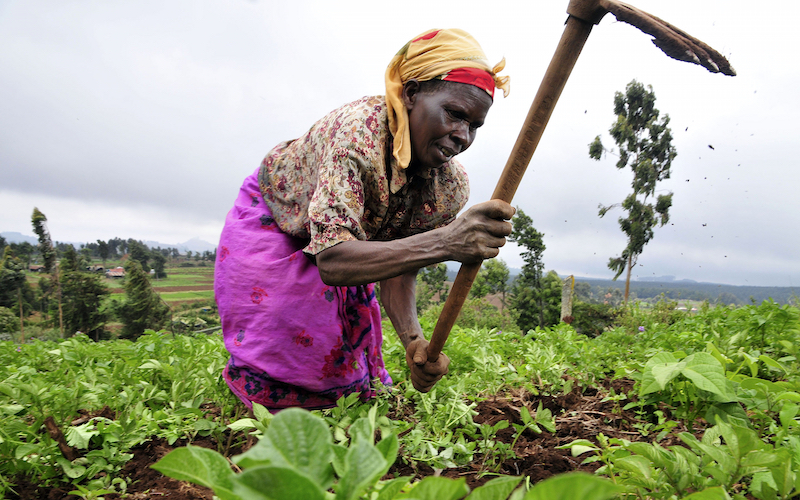
Women’s Role in Achieving a Food Secured Africa
The just ended year 2015 was the African Union’s Year of Women Empowerment. In post 2015, one thing is apparent – that Africa will not effectively achieve food security and poverty reduction unless the gender gap in economic opportunities is narrowed. Indeed the importance of women in development is well acknowledged in monumental high level policy decisions. The historic Paris Climate deal marked the first time a climate deal incorporated within its text, gender as a critical consideration when taking action to address climate change. “Women’s access to reliable markets,” also highlights the vital need to achieve gender parity to realize meaningful development. This is in sync with Africa’s own development blue-print, the AU Agenda 2063, which mentions gender parity no less than 35 times, and envisions full gender equality in all spheres of life by 2030.
A food secured Africa
The importance of women empowerment to enhancing agro-productivity and hence combating poverty as underscored in the AU Agenda 2063 is indeed validated by the statistics. Women produce up to 80 percent of food in Africa, both for household consumption and sell, work more average hours in African farms – up to 467 minutes daily compared to 371 minutes for men in some countries, and yet remain marginalized from factors of production. Gender stereotypes and dynamics such as land rights, education, access to technologies, labour, capital, support services and credit, are among stumbling blocks on the path of women progress.
Overlooking women in agriculture means Africa is losing out on a great income and livelihood creating opportunity. This is critical considering agriculture employs an average of 64 percent of the population and women produce up to 80 percent of the food.
Consequently, enhancing productivity of women who produce most of the food is a critical step towards optimizing agricultural productivity in Africa.
The World Bank estimates that if women worldwide had equal access to productive resources (seeds, extension services, etc.), 100-150 million fewer people would go hungry every day. This goes to show the great potential that women have. The critical question is how this potential can be optimized in Africa.
Policy approaches
Invest in women financing – enhancing women access to financing has been highlighted by the AU Agenda 2063 as a potent strategy to enhance productivity of women, and hence enhance productivity of agriculture (women provide up to 80 percent of labor) and further enhance socially inclusive growth. The AU Agenda 2063 advocates for dedication of 30 percent of agricultural financing to women and countries should factor this in their budgets.
Investment
Land is a critical factor of production and most African traditions and culture do not allow women to own/inherit land. African governments can remedy this scenario by developing appropriate affirmative action land lease policy for women farmers to ensure hard working women farmers get access to productive land.
De-risk lending
Most commercial banks consider lending to agro-sector high risk and are therefore averse to this sector or peg very high interest rates. Governments, working with the private sector and the development partners can come up with appropriate de-risking tools e.g. providing integrated financial security deposited with commercial banks tied to capacity building and farmers using low-risk Ecosystems Based Adaptation (EBA) approaches to enhance chances of successful yields. Commercial loans can be issued to farmers who certify these requirements, including women farmers at low/affordable interest rates considering the 3-pronged de-risking tool – security deposited by governments; training and capacity building offered by development partners; Low risk EBA approaches used by farmers.
Incentivize women in education
At times due to cultural reasons women in rural areas are not motivated to remain in school. Governments, the private sector and development communities should come up with relevant incentives to ensure girls remain in school. Examples can include favorable terms of employment etc.
Women’s access to reliable markets
Affirmative action policies in accessing market opportunities for women will go a long way in enhancing women agro-productivity. This can be a policy to directly target women in government for agribusinesses, supply of fresh produce etc.
Ensure existing and new policy frameworks
Specifically, women are the primary caregivers in the family and their productive time, especially in rural areas, is split between family and agriculture livelihood activities.
To ensure women appropriately take part in agriculture as a livelihood activity, and their productivity is maximized, compensation and work schedule policies for women in agriculture activities should factor in the need for flexibility between home making and work.
Invest in the government and private sector
Women also form a majority of jobless youth and investing in integrated youth empowerment programs to ensure youth develop enterprises along the entire agro-value chain will go a long way in ensuring that the capacity of women in agriculture is unleashed.
Africa climate adaptation
EBA approaches have proven to safeguard agricultural yields which are less risky under climate change. As more girls attend school and engage in agriculture there needs to be better land rights, better access to financing, better access to extension and advisory services to ensure they are equipped with adequate knowledge on the low cost, low risk EBA approaches so that their agro-endeavors can be optimized. Curriculum developers at all levels of education should ensure that the principles of EbA driven agriculture are integrated from the earliest possible levels of learning to facilitate a generational appreciation of ecosystems among girls in school. This will increase awareness and likelihood of their use later on when they engage in agriculture or are in the policy planning level of an agriculture portfolio.
In addition, refresher courses on EBA should also be given to extension service providers to ensure they offer accurate, up to date advice on implementing EBA techniques to women and farmers in general.
Beyond extension workers, systematic training courses for policy makers, government personnel, planners and managers should be done on a regular basis to ensure they are abreast with the latest information on climate change and EbA strategies so that these strategies are included in the sectorial policies and plans.
Conclusion
The World Bank reports that in Africa, a 10 percent increase in crop yields translates to approximately a 7 percent reduction in poverty. Neither the manufacturing nor services sectors can achieve an equivalent impact. Growth in agriculture is at least two to four times more effective in reducing poverty than other sectors. Cumulatively an optimized agro-value chain can potentially catalyze an agro-sector worth up to $1 trillion by 2030 and create as many as 17 million jobs for the youth. However rosy this seems, it cannot be achieved as long as 80 percent of the producers remain marginalized from factors of production. African governments should therefore urgently prioritize policy actions that empower women to unleash their potential for a food secure Africa under the changing climate.


